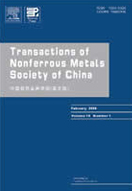Microstructure evolution of laser deposited Ti60A titanium alloy during yclic thermal exposure
(Engineering Research Center of Ministry of Education on Laser Direct Manufacturing for Large Metallic Components, Beihang University, Beijing 100191, China)
Abstract: Cyclic thermal exposure tests of infrared heating to 800 °C in 120 s followed by compressed air cooling to 150 °C in 60 s were performed for the laser deposited Ti60A (Ti5.54Al3.38Sn3.34Zr0.37Mo0.46Si) alloy. The effects of thermal exposure cycles on length of β phase, area fraction of α phase and microhardness of alloy were examined by OM, SEM and EDS. The results indicate that thermal exposure cycles have significant effects on length of β phase, area fraction of α phase and microhardness of the alloy. The original fine basket-weave β and 78.5% α transform to transient wedge-like β, finally leaving granular β and 97.6% coarsened α with the increased thermal exposure cycles. The formation mechanism of coarsened α and broken-up β microstructure is discussed. The alloy after 750 thermal exposure cycles has the maximum microhardness, 33.3% higher than that of the as-deposited alloy.
Key words: laser melting deposition; titanium alloy; cyclic thermal exposure; microstructure

